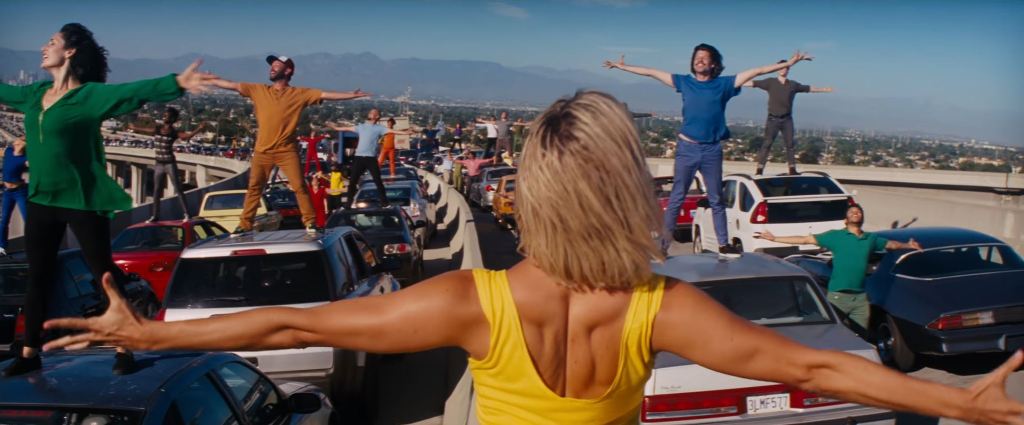Film: La La Land--The Great Millennial Musical?
La La Land is making a big run at the Oscar for Best
Picture this year, remarkable for a film musical, a genre that mostly expired long ago (Hairspray and the unlikely Björk/Lars von Trier Dancing in the Dark are exceptions). I think this movie does a nice job of updating this form. It did not
inspire me in the end, but I thought there were some truly excellent elements of it that
give some hope to those of us who like singing and dancing to accompany acting.
The strongest
aspect of the film is its visual look. The very opening shows us how vibrant
color will be a dominant feature. Director Damien Chazelle puts his cards right
out on the table by daringly beginning with a jazzy introductory production number
excitingly executed on top of gridlocked, vibrantly multicolored dancers and cars framed
against a grey backdrop of freeways and brown hills so familiar to those of us
who grew up in LA.
When composers start us right off with an uptempo chorus production number (e.g. Fiddler on the Roof ("Tradition"), A Funny Thing Happened on the Way to the Forum "Comedy Tonight", or Verdi's Otello, the effect is often "pow"--here is fullblown musical theater, take it or leave it. Throughout this movie, exciting color mixtures in costumes and sets dominate the screen. This is a really beautiful movie to look at, and reminded me of the way color was often used to exciting effect in the classic 1950's musicals like Singin' in the Rain (see comparative photos below).


Interestingly, Chazelle often uses a splash of vibrant color as a sort of a structural motif to tell us that a musical number is about to happen, rather like opera uses harmonic cadence during recitatives, or older musicals use poetic set-up dialogue. This is a really effective way to put the viewers in a warm mood to start out the song and dance numbers.
The traditional elements of musicals, i.e. acting, singing,
dancing, and music, were good but less compelling. The two leads, Emma Stone
and Ryan Gosling, are well matched, but not natural musical theater types--they
both had to learn how to tap dance for this film, for example. The director
creates several well done duets for them without taxing their resources too
much—this is not Astaire and Rogers. Gosling can’t really sing at all, but has
a sexy growl that works fine. Stone is more convincing (she did do Sally Bowles in Cabaret on Broadway), reminding me of a more
innocent version of Cyd Charisse, singing and dancing like a pro. The two of
them, at least when they dance together, form an appealing old-fashioned couple, clearly
harkening back to an older less cynical age. The music was an attractive hybrid
of jazz and pop, more interesting than that of many recent musicals, but without being
really compelling or leaving you with any memorable tunes (that seems to be a
long lost art, alas). If I were to
critique anything about the song and dance in the movie, it would be that I wanted more of
it. Chazelle and TV choreographer Mandy Moore (not the actress) clearly know how
to produce a great ensemble number (i.e. the exciting freeway opening). I wished I saw
more of this. With all their dramatic limitations, the great Busby Berkeley musicals
from the 1930’s knew to build to a big production finish. That would have been
welcome here.
Like most musicals, this one has a thin plot, superimposing two hoary
musical theater schemata: a nobody can become a star, and boy-gets-girl-loses-girl-gets-girl
(although the latter reunion occurs in sort of an alternate universe,
increasingly a cliché of modern movies). Chazelle (born in 1985) has written
perhaps the iconic millennial show here. Unlike older musicals where love, or
progress, or the USA conquers all, here the individual aspirations of the leads
conquer all. Millennials are known for their, ahem, self confidence in holding
to their ultimate dreams, often rejecting practicality, money, and seasoned
advice from their elders to do so. This is romanticized to the T in La La Land. Gosling’s character’s
passion is to open an old-fashioned jazz club, rejecting attempts to update
jazz and make it more forward-looking as untrue to himself, hence romanticizing
his conservatism since, above all, he is true to himself. Stone’s character,
pointedly, gets her big break performing in a one-woman show, perhaps the best
metaphor for millennial accomplishment that I know. The ending is the most
telling sign that we are seeing another generation’s vision. While a romantic
reunion of the leads is dangled in front of us, their individual careers win
out in the end--not sadly, but with the same ambivalence I see all the time in
my millennial students. Incorporating an alternate universe at the movie's end is the
perfect allegory for millennial angst. The great question of young people in
2017 seems to be “What do I really want”, rather than any form of question
involving “we”. That this does not all come across as insufferable film
narcissism, and somehow blends with the "we" of romantic song and dance, is a credit to the film’s director and writers. La La Land succeeds both as voluptuously beautiful cinema, and as
an updating of the film musical that simultaneously honors the genre’s
traditions and the aspirations and anxieties of today’s young people. While it
did not touch me deeply, I was not, after all, its target audience.
Comments
Post a Comment